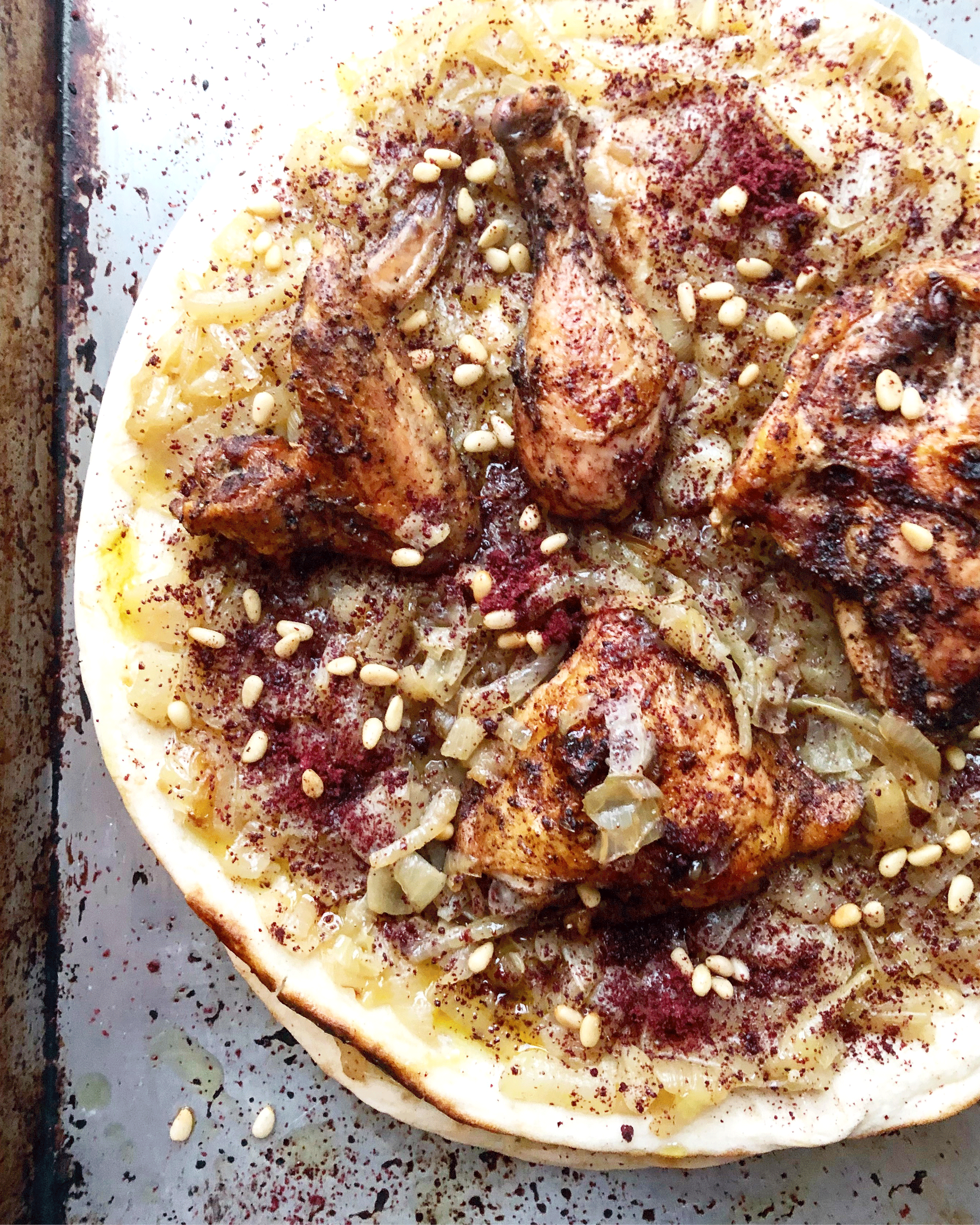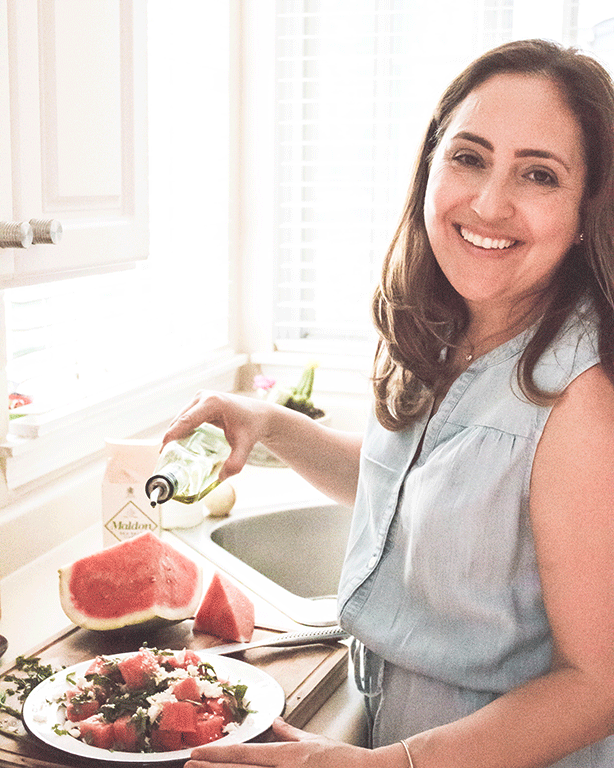This month’s food and memory story is by Mai from Almond and Fig blog. Mai’s connection with food is one that takes her back to Palestine, where she grew up. Her account is both an ode to musakhan, a typically Palestinian dish, and a declaration of love for a life and a culture.
Mai, is the editor, writer, cook, and grocery shopper behind the Almond & Fig blog.
She grew up in Palestine, and now lives in Chicago with her husband David, their three girls and dog Mickey. Her cooking was inspired by her mother’s and her mother’s mother. She loves to recreate dishes from her childhood and through them re-live the happy moments in her family’s kitchen in Palestine. She believes that food is her way to inspire, tell a story, preserve traditions as well as make new ones.
Tita’s Musakhan by Mai Kakish
Charred bread soaked with golden olive oil, tangy sumac, sweet caramelized onions, and loads of crispy chicken come to create Palestine’s most popular and traditional dish, the glorious musakhan.
Throughout the olive harvest season, my grandmother, Tita, had her house packed with relatives, grandkids, and neighbors who eagerly awaited her famous musakhan. She could be found at the crack of dawn, with her handmade apron firmly tied, drinking a warm glass of milk on the verandah adjacent to the kitchen and overlooking the garden, listening to the morning radio. Once the news over she would start to cook. Songs from Fairuz – a Lebanese singer who is one of the most widely admired and deeply respected living singers in the Arab world, and definitely loved by my Tita – kept her company as she carefully prepared her musakhan masterpiece. She peeled and chopped bushels of onions and when her eyes stung and swelled up with tears she would say “this a sign that the onions are fresh”. While the olive oil and onions sizzled on the stove, Tita prepared the bread-dough made out of a mix of flours, yeast, olive oil and other base ingredients which she would bake in her old-fashioned oven. The oven, the only one that she trusted to bake her goodies, was an electric round range which was placed on the floor. Tita sat on a little stool and baked dozens of large taboon bread rounds. The beautiful aroma of caramelized onions and fresh chicken floated throughout the house and lingered on for days.
My aunt, or Amto, Aida who was the queen of hospitality, would set an elaborate table. The long dining table looked colorful and inviting with perfectly aligned place settings, small glasses for drinking Arak – an aniseed flavored alcoholic drink – buckets of ice, little bowls of Tita’s thick homemade yogurt, olives, pickles, freshly chopped vegetables and sprigs of mint. Tita and aunt Aida were always the last ones to eat, making sure that everyone was served first. Going to Tita’s and Amto’s house meant that we would never leave hungry, they piled our plates mountain high, and always offered seconds, thirds, and definitely all the leftovers to take home.
I loved our big family dinners at Tita’s house. The conversation was always loud, the food always abundant, and my Tita always smiling at the pure joy of seeing her whole family gathered. Tita’s musakhan is a connection to a collection of stories told at her dinner table, the memory of which will last for a lifetime.
Most of our extended family is now scattered all over the world, but one day a musakhan feast will bring us back together at Tita’s house.
The word “musakhan” literally means something that is heated. It is usually presented with a generous amount of chicken on top of the bread, and can be served with a simple broth-based soup; typically, this would be the broth from the chicken which was boiled before roasting. Musakhan is a dish that we typically eat with our hands, just like pizza. If you are ever invited to eat musakhanand there is no knife nor fork, don’t say I didn’t warn you! Trust me, it tastes better eaten this way. Taboon is the key ingredient to musakhan, together with the onions and sumac of course! The name taboon refers to the oven used to bake the bread. Traditional Palestinian taboon ovens are dome shaped and often made of clay. The floor or bottom of the oven is usually covered in large pebbles which were heated by smoldering hot coals. The round flatbread dough was placed directly over the pebbles, resulting in charred indentations underneath the bread.
Ingredients
- 1 Fryer chicken cut into 4-6 pieces ∗
- 2 cups extra virgin olive oil
- 14 onions, coarsely chopped ∗∗
- 2 medium taboon bread ∗∗∗
- 1/3 cup good quality ruby sumac plus 1 tablespoon
- Pine nuts
- Salt
- Black pepper
- 1 tablespoon allspice
- 1/2 teaspoon ground cinnamon
- A pinch of ground nutmeg
- 1/2 teaspoon ground cardamom
Method
- The chicken: You could boil the chicken first with aromatics to make a broth, then strain it, and then roast the cooked chicken in the oven. I however just drizzle the chicken pieces with olive oil, rub spices all over the chicken, and bake in 375°F/ 190°C oven for 40-50 min until cooked through and the skin is crispy and browned.
- The onions: In a heavy large pot, heat the olive oil. Sauté the onions until completely soft not browned. This process takes time, up to 30-45 minutes depending on how deep or shallow your pot is. Season with salt and pepper to taste. Off the heat, add the sumac saving 1 tablespoon for the garnish.
- To Assemble: Dunk the chicken in the olive oil and onion mixture. Generously scatter the caramelized onions over the taboon bread. Add the chicken pieces on top. Sprinkle with pine nuts and the rest of the sumac. Return to a pre-heated oven at 350°F/180°C for 10 minutes until the bread crisps up and soaks up all the flavors.
- To eat: Serve each person either a whole loaf or half based on the size of your bread. With a piece of chicken on top. Cut pieces with your hand making sure every bite has lots of onions and chicken. Serve with lots of napkins and don’t be scared to get messy.
∗ The USDA defines a fryer chicken as between 7 to 10 weeks old and weighing between 2-1/2 and 4 -1/2 pounds.
∗∗ You want enough onions to generously cover the taboon bread.
∗∗∗ Use your judgment because taboon comes in various sizes
Cooking time
Preparation time
Serves





Leave a Reply
Want to join the discussion?Feel free to contribute!